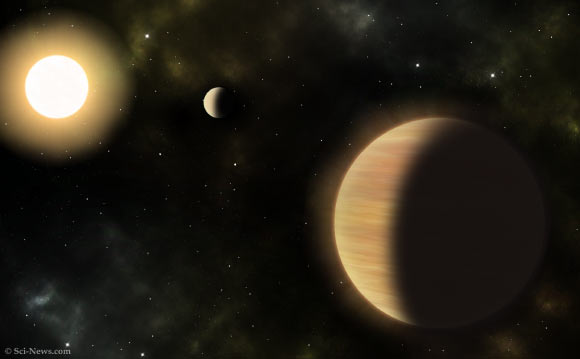Astronomers using NASA’s Transiting Exoplanet Survey Satellite (TESS) have discovered a planetary system of two giant planets — a Neptune-sized planet and a hot Jupiter — orbiting the 8.2-billion-year-old star TOI-1130.
Source: Sci News
Hot Jupiters are massive gaseous exoplanets with orbital period less than 10 days. The short period means that these gas giants are very close to their host stars, usually less than 0.1 AU.
These planets are rarely accompanied by other planets within a factor of a few in orbital distance.
Previously, only two such systems have been found: WASP-47 and Kepler-730.
“TOI-1130 is only the third star known to have a transiting giant planet with an orbital period shorter than 10 days as well as a second transiting planet,” said MIT astronomer Chelsea Huang and her colleagues.
“The star is brighter than the host stars of the previously known systems, especially at infrared wavelengths, which should provide good opportunities to study this type of system in detail.”
TOI-1130 is an 11th magnitude K-dwarf star located about 190 light-years away in the southern constellation of Corona Australis.
Also known as TYC 7925-02200-1 or TIC 254113311, the star is about 32% smaller and less massive that the Sun.
TOI-1130 formed about 8.2 billion years ago, and hosts two transiting exoplanets: TOI-1130b and c.
The inner planet, TOI-1130b, is a Neptune-sized world with a 4.1-day period and a surface temperature of 527 degrees Celsius (981 degrees Fahrenheit).
This planet is 3.65 times bigger than Earth, and has a maximum mass of about 0.17 Jupiter masses.
The outer planet, TOI-1130c, is a hot Jupiter with an 8.4-day period and a surface temperature of 364 degrees Celsius (687 degrees Fahrenheit).
This world has about 0.97 times Jupiter’s mass and a radius of 1.5 Jupiter radii.
Dr. Huang and co-authors discovered TOI-1130b and c using data collected by TESS.
“The discovery of TOI-1130 illustrates TESS’ power to find systems with rare architectures,” the astronomers said.
“With a large amount of TESS data still unexplored, we can expect more systems such as TOI-1130, along with better knowledge of the frequencies of different types of hot Jupiter systems.”
They then confirmed the existence of the two planets using ground-based observations with Pan-STARSS, TRAPPIST-South and SMARTS telescopes.
“TOI-1130 is a K7 star, which is the smallest star known to host similar type of system architecture to-date,” they said.
“It is relatively bright at near-infrared wavelengths, making the planets a good target for transit spectroscopy to study planetary atmospheres.”
“Specifically, the atmospheric signal of TOI-1130c is probably detectable with the NASA/ESA Hubble Space Telescope. Comparisons between its atmosphere and that of the other hot and warm Jupiters may help us understand its origin.”
The team’s paper was published in the Astrophysical Journal Letters.
Source: Sci News

































Leave a Comment
You must be logged in to post a comment.